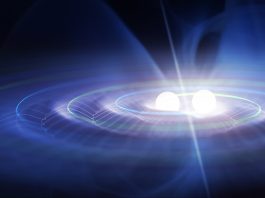The search for dark matter is one of science’s greatest mysteries. As it doesn’t absorb, reflect or emit light, we can’t see it.
Although it makes up about 85% of the cosmos, scientists know very little about its fundamental nature, and the search for dark matter has not yet been complete.
Several theories and research by Clemson University postdoctoral fellow Alex McDaniel provide some of the most stringent constraints on the nature of dark matter yet.
His research also reveals a small hint of a signal that, if real, could be confirmed sometime in the next decade or so.
“With data collection and new discoveries in the future, this small hint could potentially turn into a very concrete detection of a dark matter model,” McDaniel said.
The findings were detailed in a paper in Physical Review D.
If detected, information about dark matter would be groundbreaking
Completing the search for dark matter would be revolutionary.
“Dark matter is one of the most important things in astrophysics, and we know next to nothing about it. Discovering it will be a tremendous breakthrough,” said Marco Ajello, an associate professor in the Clemson Department of Physics and Astronomy and McDaniel’s adviser.
Ruling out potential theories in the search for dark matter
In this work, McDaniel and collaborators were searching dwarf galaxies for dark matter that self-annihilates into ordinary matter and gamma rays, a form of light at the highest energy levels.
Dwarf galaxies are ideal for study because they are small, rich in dark matter and mostly lack other astrophysics phenomena such as gas, dust and supernovas that could contaminate the findings.
McDaniel explained: “We look for these because, ideally, they give us a clean signal or allow us to rule out certain particle theories.”
Some models predict that dark matter has a certain mass or cross-section, which is the probability of a specific event occurring due to the interaction of particles. That would determine what researchers would expect to see in gamma rays.
If they don’t see that, they can rule out those masses and cross-sections.
Chris Karwin, a postdoctoral fellow at the NASA Goddard Space Flight Center and co-author of the study, explained: “In this paper, we do more ruling out, saying that dark matter can’t have those masses or cross-section.
“But compared to previous studies, we do start to see a hint of something that might be a signal from these systems.”
New, innovative technology could further the search
McDaniel’s study uses larger samples that include additional discovered dwarf galaxies and larger amounts of data than previous studies that search for dark matter.
He included about 50 dwarf galaxies in his study but said that, with new, more powerful telescopes coming online soon, he expects that number to increase to 150-200.
“The new telescopes are basically dwarf galaxy detectors,” he said.
“We’re projecting with those improvements it’s possible that instead of having just a little hint of a signal, we can have something that’s a bona fide detection.”
Ajello concluded: “If the signal is real, eventually it will be confirmed.”





